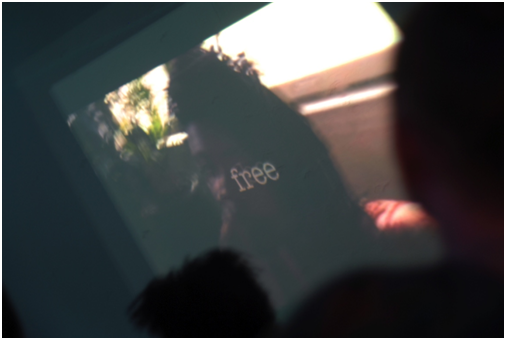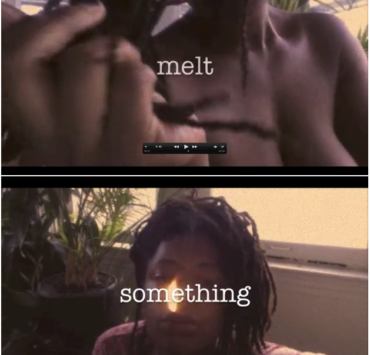
girls
read a homemade sign on a wooden gate
in
their
bedrooms
read another as I passed through the swinging doors to the front yard of The PoppyCock ArtSpace. From the front porch, I walked inside an open door and climbed one flight of stairs where I found a gathering in the hallway. The hallway, a bridge between universes.
Something about the bodies coming together between rooms reminded me of sisters and girlfriends clustering in hidden corners where hallways aren’t just highways but mediated physical spaces wherein infinite translations occur.
Inside the first bedroom, a bright abstract floral quilt haphazardly made the bed; a stack of books piled high from the floor assembled titles into “a book poem;” stems of flowers lay scattered in loose array; colored pencils stood in an unopened box. In neon tubes of light, “negro sunshine” glowed from the cover of a book and Vera Pavlova’s paradoxical poem on desire and regret stuck to the wall. Tucked into the foot of the bed – a heating blanket bunched, unplugged.
“That’s Gabrielle’s room,” said a voice in the hall, “she was just here, I don’t know where she’s gone off to now.”
She hadn’t left actually. I could see her just around the corner, inside the closet, with another group. Her expression was solemn but when our eyes met, Gabrielle moved out into the bedroom, smiled wide and exclaimed,
“Sarah Hollows! The girl who wasn’t snaaaaaaatched!”
(Later, the significance of this would hit me deep and send an aching crack through my bones but, in the moment, it was an endearing surprise.) We hugged each other hard as she held the ‘a’ in snatched like a song or a moan. I didn’t understand but was aware that some sort of transition had occurred between the closet and the end of the bed where we now stood. I asked what was happening inside the room she had just emerged from but we didn’t talk much about it. She moved toward the bed and said that what was going on in that room was a different girl entirely.
She said that this room was for the
LOUD AMERICAN girl,
but that I would need to check in with that girl, gesturing through a window in the bedroom/closet wall, later on. We piled onto her bed forgetting ourselves for a while, as if about to be absorbed into the safety and comfort of a slumber party, but were quickly called up to the attic where performances were about to begin. I glanced over my shoulder on the way out of her room amid an excited movement of bodies, but I couldn’t see into the closet.
Across the hall was another bedroom housing the stairwell to the attic and an installation by Ellen Marie Hinchcliffe. The perimeter of the room had been circled with a thick line of what looked to be cornmeal, making/marking sacred space or ritual. This bedroom was quieter than the first and there was a stillness about it. From the ceiling, on translucent strands of what is commonly used to catch fish, loose, blank pages were hanging – maybe flying. They held each other in the air as if waiting to be filled, containers for lost and forgotten memories, memories that ought to be forgotten, revelations that have not yet occurred, perhaps even prayers. My attention went to the floor where flower petals rested like rain, offering a delicate bed that would wrinkle and fade in time. Passing through this space was like crossing under a waterfall – I felt simultaneously strengthened and protected, yet aware of something at risk. If ever there was a way to describe my sense of a feminist community, that might be it.
Up in the attic, sweaty, laughing, curious bodies leaned forward to absorb every detail, each one beginning its own translation of the texts. Liquor and laughter made thick, hot energy that competed with the air conditioner and fan. Ellen presented an altar to honor the memories of Maya Angelou and Paula Gunn Allen, and when she spoke their names I’d have sworn the room felt fuller. An art letter video spoke of bedrooms as sites for creativity, yes, but also for restoration and healing. A silent video in black and white attempted the truth while a story told another. A new kind of economy: red balloon, the ceramic bust of a young black girl, a bottle wrapped in sequins. To share a memory (a favorite thing) is not the same as to give it away. Among strangers and friends, how do we decide what to believe; who to trust; how much to share/give of ourselves?
It wasn’t until intermission that I was able to return to Gabrielle’s closet downstairs. It was dark and on the floor there was a candle. A milk crate supported a thick stack of papers with either
the name of a girl typed out
or the phrase
“a girl who was snatched.”
An article, “Nigeria: dozens of girls kidnapped” was posted on the wall. #BringBackOurGirls flashed in my mind and the marrow in my bones was heavy as lead remembering the LOUD AMERICAN girl and that window in the wall, how close I had been to this thing and how different it had felt. What happens when a girl’s bedroom isn’t safe, when what is precious cannot be protected there?
There was something about the proximity of these two rooms – one within the other. At first they had seemed wholly separate, but I came to understand them as necessarily joined in creative and existential substance. The window in the wall became an artery transporting the pulse of a global crisis to the limbs of the LOUD AMERICAN girl. What was she to do with that? What would she do with that? Girls in Their Bedrooms, I thought. In the body of a bedroom, the closet beats.
Back in the attic and sitting on the floor, Michelle Be unfolded papers from inside of an envelope as if unfolding a part of herself. In no particular order she began to read from the poems and streams of thought she had surrounded herself with, stopping as she sensed a resonance with the audience to weave the written word with an ever-evolving dialogue of ideas spoken out. Words grew more specific in response to a room filled with body language and mmmmm’s.
In Junauda Petrus’s short video I saw the order of time collapse as thick smoke released from her lungs only to turn back around and repeat –a slow return and release played back over and in on itself as the phrase “be free” appeared over her face. The repetition of her breath was like a ritual engaging with that desire: be free, be free, be free. A challenge or a plea?

What happens when a group of women open up intimate space to name and embody the questions that haunt, inspire and confound them? Amidst each piece was a seemingly intentional sense of being in process or unresolved. Mankwe Ndosi’s improvised sounds/songs were a poetic manifestation of her statement, “There’s something about always having the sounds around and never knowing the meaning.”
What are the sounds that surround us at every moment; what fragments of recognition are sparked when the words aren’t what we understand? When a gesture or a cry, silence or repetition creates a space to enter into, even if what is there raises more questions than answers. What thresholds must we pass over or through in order to begin to understand?
From the Hive took me to that space as both a time capsule and a cauldron of possibility. A place for memories to be made, recalled and desperately (tenderly) held onto, or carefully revised for survival. Where family is, but set apart. The space where secrets are dealt with, revealed, embodied, protected, written, sung. Where rage, rest and resistance weave strange fibers. Where the meanings of words are born and wrestled with, and sometimes not settled upon because bodies, because ideas, because questions don’t always make sense with language attached.
Perhaps more than anything, “Girls in Their Bedrooms” left me with the undeniable sense that there’s something about doing and being together that helps us to reconcile existence with what we can’t understand. At the end of the night I saw an altar on the stage, between the heads and shoulders of those sitting near the front, and the late, remarkable Maya Angelou’s words sounded in my mind:
“A bird doesn’t sing because it has an answer, it sings because it has a song.”

Sarah Hollows is an interdisciplinary artist focusing particularly on performance, relational and social practice. She is interested in both destroying white supremacist capitalist patriarchy, and investigating the invisible element that exists/is activated/comes to life once a relationship is initiated or a gesture is received. Recent work includes "HOLDING ON/LETTING GO" and "Settlements," both artistic collaborations with Kris Mason, and "Off the Menu" (not of the menu) an on-going relational experiment imagining and practicing an economy of kindness. Sarah is a graduate student in Intermedia at the University of Maine (Orono) where she also co-runs “Hide and Seek,” a collaboratively run coffee shop/ experimental art station on campus.







